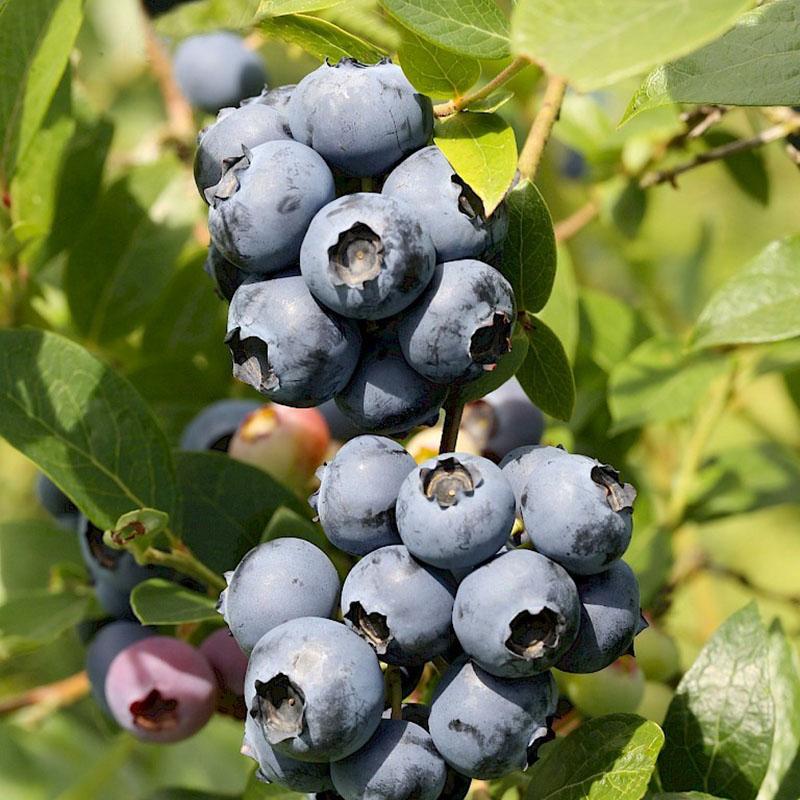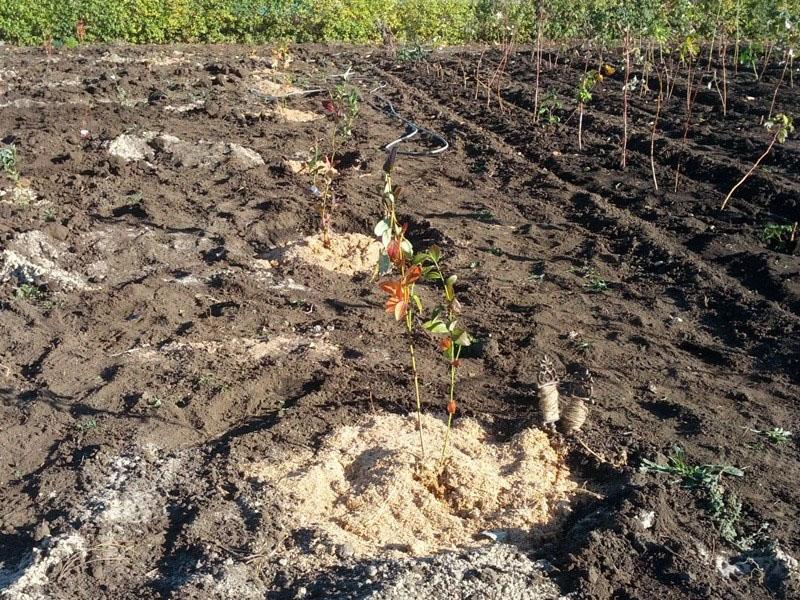What care does Northland tall blueberry need?
 Northland tall blueberry is one of the best frost-resistant varieties, specially created for growing in northern regions with harsh climatic conditions. With the creation of comfortable conditions and proper care, blueberries can be grown in the garden or in the garden, getting a bountiful harvest of tasty and healthy berries.
Northland tall blueberry is one of the best frost-resistant varieties, specially created for growing in northern regions with harsh climatic conditions. With the creation of comfortable conditions and proper care, blueberries can be grown in the garden or in the garden, getting a bountiful harvest of tasty and healthy berries.
Tall blueberries Northland - main features

Description of the Northland blueberry variety:
- Bushes are powerful and spreading, up to 1-1.3 m high, with numerous, dense shoots.
- The root system is fibrous, superficial.
- The shoots are straight, even and flexible enough to easily support a large weight of ripe berries and snow.
- Leaves are oblong, up to 3 cm long, with a smooth, glossy green surface. In September-October, they acquire a crimson-red color.
- Inflorescences are five-toothed, small, bell-shaped.
- The berries are large, round, with a thin blue skin, covered with a bluish bloom. The taste is delicate and sweet.
- Northland is one of the best frost-resistant blueberry varieties that can withstand air temperatures down to -35 ° C.
Gardeners appreciate the tall Northland blueberry for its excellent frost resistance, high yield, good taste and decorative appearance of the bush.
Planting tall blueberries
 Planting and caring for Northland blueberries requires compliance with all the rules, since this species was created specifically for growing in regions with a harsh climate. Planting work can be carried out both in early spring and in autumn. The first option is considered more preferable, since the seedlings will have time to take root firmly, adapt to new growing conditions and prepare for winter frosts.
Planting and caring for Northland blueberries requires compliance with all the rules, since this species was created specifically for growing in regions with a harsh climate. Planting work can be carried out both in early spring and in autumn. The first option is considered more preferable, since the seedlings will have time to take root firmly, adapt to new growing conditions and prepare for winter frosts.
Site and soil selection
 For planting, biennial plants up to 35-50 cm in height with a healthy, closed root system are best suited. Blueberries are light-loving crops, so choose an open area that is well lit but protected from drafts.
For planting, biennial plants up to 35-50 cm in height with a healthy, closed root system are best suited. Blueberries are light-loving crops, so choose an open area that is well lit but protected from drafts.
Tall Northland Blueberries should not be planted in the shade of fruit trees or under buildings. The lack of sunlight leads to the fact that a sharp "sourness" appears in the taste of berries, and the crop yield is almost halved.
 Young seedlings need nutritious, light and well-drained soil. It can be additionally fed humus... The optimal acidity index is up to 3.8-4.5 pH. High moor peat or a mixture containing it is often used to grow the Northland variety.
Young seedlings need nutritious, light and well-drained soil. It can be additionally fed humus... The optimal acidity index is up to 3.8-4.5 pH. High moor peat or a mixture containing it is often used to grow the Northland variety.
Algorithm and scheme of landing
 To plant tall Northland blueberries, prepare holes - their depth and diameter should be at least 50-60 cm.The optimal distance between bushes in a row is about 1.3 m, leave 2.4-2.6 m between rows.
To plant tall Northland blueberries, prepare holes - their depth and diameter should be at least 50-60 cm.The optimal distance between bushes in a row is about 1.3 m, leave 2.4-2.6 m between rows.
Step-by-step landing:
- Pour a drainage layer of rubble, pebbles and expanded clay on the bottom of the prepared holes with a height of at least 10 cm.
- Pour a nutrient composition from needles, garden soil, humus and peat (12-15 cm) into the hole.
- Dip a blueberry seedling into the hole and gently straighten its roots.

- Sprinkle the seedling with soil so that there are no voids in the hole.Try not to tamp too much, otherwise you can damage the roots of the plant.
- Mulch with nutshells, peat or sawdust.

After planting, water the blueberry bushes with acidified water and citric acid (2 tablespoons per bucket of water).
Northland Blueberry Care
 Proper and regular care of Northland blueberries is the key to active growth, high yields and long-term fruiting of the plant. Care consists of systematic watering, loosening the soil and applying top dressing.
Proper and regular care of Northland blueberries is the key to active growth, high yields and long-term fruiting of the plant. Care consists of systematic watering, loosening the soil and applying top dressing.
Watering and feeding blueberries
 Northland blueberries need regular watering - water the bushes every 6-7 days.
Northland blueberries need regular watering - water the bushes every 6-7 days.  During the fruiting period, watering becomes more frequent up to 1 time every 3-4 days.
During the fruiting period, watering becomes more frequent up to 1 time every 3-4 days.  One plant will need a bucket of standing water. It is best to split it in two by moisturizing the blueberries in the morning and evening after sunset.
One plant will need a bucket of standing water. It is best to split it in two by moisturizing the blueberries in the morning and evening after sunset.
 For feeding Northland blueberries, use fertilizers with a high concentration of nitrogen, as well as special complex formulations.
For feeding Northland blueberries, use fertilizers with a high concentration of nitrogen, as well as special complex formulations.  The first feeding of the plant is carried out before the start of sap flow, the second during the flowering period, the third - during the formation of the ovaries.
The first feeding of the plant is carried out before the start of sap flow, the second during the flowering period, the third - during the formation of the ovaries.
For fertilizing tall Northland blueberries, it is better not to use organic matter - it contains an increased concentration of biologically active substances that can harm the plant.
Loosening the soil and pruning shrubs
 In order for blueberries not to experience a lack of moisture and nutrients, it is necessary from time to time to loosen the soil near the bushes and remove weeds. The soil should be loosened to a depth of 8-12 cm, being careful not to injure the blueberry root system. This will prevent oxygen starvation of the bush.
In order for blueberries not to experience a lack of moisture and nutrients, it is necessary from time to time to loosen the soil near the bushes and remove weeds. The soil should be loosened to a depth of 8-12 cm, being careful not to injure the blueberry root system. This will prevent oxygen starvation of the bush.
 Blueberries of the Northland variety are characterized by rather slow growth, so they do not need frequent pruning. They are best done in early spring, removing all weakened, diseased and non-viable shoots.
Blueberries of the Northland variety are characterized by rather slow growth, so they do not need frequent pruning. They are best done in early spring, removing all weakened, diseased and non-viable shoots.
To increase the crop yield, all shoots are removed that are more than 7-8 years old. You can also prune five-year-old branches to help increase the size of the berries.
Blueberry diseases
 Northland can be affected by various diseases - gray rot, physalosporosis, moniliosis. To combat them, are used Topsin preparations, Fundazol, Bordeaux mixture.
Northland can be affected by various diseases - gray rot, physalosporosis, moniliosis. To combat them, are used Topsin preparations, Fundazol, Bordeaux mixture.  For the prevention of these diseases, it is very important to avoid stagnation of moisture in the soil and an excess of nitrogen-containing fertilizers.
For the prevention of these diseases, it is very important to avoid stagnation of moisture in the soil and an excess of nitrogen-containing fertilizers.
The tall Northland blueberry is a popular variety appreciated by gardeners for its high yield. It is frost-resistant, unpretentious in care and has excellent taste qualities of berries. When complying with the obligatory agrotechnical rules, Northland will become a real decoration of any garden and will bring a generous harvest of tasty and juicy berries.